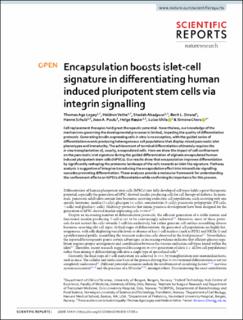| dc.contributor.author | Legøy, Thomas Aga | |
| dc.contributor.author | Vethe, Heidrun | |
| dc.contributor.author | Abadpour, Shadab | |
| dc.contributor.author | Strand, Berit Løkensgard | |
| dc.contributor.author | Scholz, Hanne | |
| dc.contributor.author | Paulo, Joao A. | |
| dc.contributor.author | Ræder, Helge | |
| dc.contributor.author | Ghila, Luiza | |
| dc.contributor.author | Chera, Simona | |
| dc.date.accessioned | 2020-11-13T14:16:23Z | |
| dc.date.available | 2020-11-13T14:16:23Z | |
| dc.date.created | 2020-09-28T16:17:32Z | |
| dc.date.issued | 2020 | |
| dc.identifier.citation | Scientific Reports. 2020, 10, . | en_US |
| dc.identifier.issn | 2045-2322 | |
| dc.identifier.uri | https://hdl.handle.net/11250/2687869 | |
| dc.description.abstract | Cell replacement therapies hold great therapeutic potential. Nevertheless, our knowledge of the mechanisms governing the developmental processes is limited, impeding the quality of differentiation protocols. Generating insulin-expressing cells in vitro is no exception, with the guided series of differentiation events producing heterogeneous cell populations that display mixed pancreatic islet phenotypes and immaturity. The achievement of terminal differentiation ultimately requires the in vivo transplantation of, usually, encapsulated cells. Here we show the impact of cell confinement on the pancreatic islet signature during the guided differentiation of alginate encapsulated human induced pluripotent stem cells (hiPSCs). Our results show that encapsulation improves differentiation by significantly reshaping the proteome landscape of the cells towards an islet-like signature. Pathway analysis is suggestive of integrins transducing the encapsulation effect into intracellular signalling cascades promoting differentiation. These analyses provide a molecular framework for understanding the confinement effects on hiPSCs differentiation while confirming its importance for this process. | en_US |
| dc.language.iso | eng | en_US |
| dc.publisher | Nature Research | en_US |
| dc.rights | Navngivelse 4.0 Internasjonal | * |
| dc.rights.uri | http://creativecommons.org/licenses/by/4.0/deed.no | * |
| dc.title | Encapsulation boosts islet-cell signature in differentiating human induced pluripotent stem cells via integrin signalling | en_US |
| dc.type | Peer reviewed | en_US |
| dc.type | Journal article | en_US |
| dc.description.version | publishedVersion | en_US |
| dc.source.volume | 10 | en_US |
| dc.source.journal | Scientific Reports | en_US |
| dc.source.issue | 10 | en_US |
| dc.identifier.doi | 10.1038/s41598-019-57305-x | |
| dc.identifier.cristin | 1834455 | |
| dc.description.localcode | Open Access This article is licensed under a Creative Commons Attribution 4.0 International License, which permits use, sharing, adaptation, distribution and reproduction in any medium or format, as long as you give appropriate credit to the original author(s) and the source, provide a link to the Creative Commons license, and indicate if changes were made. The images or other third party material in this article are included in the article’s Creative Commons license, unless indicated otherwise in a credit line to the material. If material is not included in the article’s Creative Commons license and your intended use is not permitted by statutory regulation or exceeds the permitted use, you will need to obtain permission directly from the copyright holder. To view a copy of this license, visit http://creativecommons.org/licenses/by/4.0/. | en_US |
| dc.source.articlenumber | 414 | en_US |
| cristin.ispublished | true | |
| cristin.fulltext | original | |
| cristin.qualitycode | 1 | |

